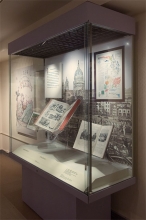exhibition
Picasso: 19 Plats en Argent
One of the best-known artists of the 20th century, Pablo Picasso was a Spanish painter, sculptor, printmaker, ceramicist, stage designer, poet, and playwright who spent most of his adult life in France. Picasso is often remembered for his cubist paintings, but he continued to experiment with new styles and materials throughout his life. During the 1950s and 1960s, Picasso commissioned Francois Hugo, great-grandson of French writer Victor Hugo, to execute a series of plates, dishes, and medallions in gold and silver. The plates were modeled after Picasso’s original ceramics designs.
Sculptures Precieuses et Bijoux de Braque
Georges Braque was a major 20th-century French painter, sculptor, draughtsman, and printmaker. At the age of 79, Braque turned his attention to jewelry. He teamed up with master jeweler Baron Heger de Löwenfeld to turn 110 gouache maquettes into intricately textured gold sculptures inlaid with precious stones. The collection, inspired by Greek mythology, incorporates themes of flight and metamorphosis. The two artists worked so closely together that Braque referred to De Löwenfeld as the “continuation of my hand.”
Wind & the Willows: Iron & Gold in the Air, Dust & Smoke on the Ground
Lawrence Weiner is a conceptual artist who has used language as his primary medium since 1968, when he concluded that viewers could experience the same effect from reading a verbal description of his work as they could from viewing the work itself. Since that point, he has been best-known for his word sculptures—short poems and witticisms applied to walls in plain lettering, always translated into the language of the country in which they are shown. In 1995, the Middelheim Museum in Antwerp commissioned Weiner to create a work for its permanent collection.
Lucas Samaras : Gold
The works of Lucas Samaras can be understood through one unifying principle: the artist’s “natural instinct for subversion.” Rather than springing from an urge to rebel, however, Samaras’ originality and nonconformity are centered in treating art as a mutable subject. Samaras spent two years crafting gold jewelry, modeling them first in chicken wire, then casting them in solid 22-karat gold.
Objets de Mon Affection
The “objects” of American artist Man Ray’s affection were small, limited-edition sculptures.
Picasso; Forty Years of His Art
Joseph H. Hirshhorn, founding donor of the Smithsonian Institution’s Hirshhorn Museum and Sculpture Garden, was an avid collector and supporter of Pablo Picasso. The two became friends after being introduced by photographer Edward Steichen.
Louise Nevelson: Black, White & Gold
Although black—the color that contains all colors—has been American sculptor Louise Nevelson’s signature color, the artist began incorporating white and gold into her work in the 1960s. This announcement for an exhibition of sculptures by Nevelson at The Pace Gallery, New York, October 23-November 28, 1992, reflects her limited palette. Reproductions of her assemblage sculptures are presented in three die-cut printed pop-ups, printed in silver and gold. Nevelson herself is pictured in a silver-printed portrait on the front cover. The entire elegant presentation is ribbon-tied.
Tabaimo
"'Yumechigae.' According to the dictionary, this means: A charm to divert misfortune after experiencing a nightmare." Thus opens the essay to this exquisite exhibition catalog for a solo show of Japanese artist Tabaimo’s work at the Hara Museum of Contemporary Art, Tokyo, in the summer of 2003. Tabaimo is a contemporary Japanese artist whose immersive video installations evoke Japanese woodblock prints (Ukiyo-e), manga, and anime to express the anxieties underpinning Japanese society in an age of globalization.
Visitors to Arizona, 1846 to 1980
This colorful catalog for an exhibition at the Phoenix Art Museum in 1980 presents photography, painting, and sculpture created by artists who traveled through Arizona and were inspired by the state. The 93 artists included in the exhibition and this catalog span nearly 150 years, and include Helen Frankenthaler, Thomas Moran, Frederic Remington, Dorothea Tanning and Max Ernst, and Carleton Watkins.
Gardens For a Beautiful America 1895-1935
This book presents, in all their glory, the hand-colored glass slide photographs of Frances Benjamin Johnston (1864-1952). It is a beautiful pictorial book, yet scholarly and well researched. Johnston was one of the earliest professional American women photographers. She trained as an artist in Paris, studied photography here at the Smithsonian, and began her career doing portrait and news photography.
The Wonder Book of Good Meals
"The only bread baked at the Chicago World's Fair." Wonder Bakery was the first major company to adapt commerical bread slicers. Imagine the "wonder" that was inspired when they exhibited at the Chicago World's Fair in 1934 just a few short years after the slicers were invented. The exhibition baked, sliced, and packaged bread on the spot. The Wonder book of good meals: World's Fair Edition was given out as a keepsake/advertisement to fairgoers. It includes recipes for every course, as well as defining "whitchery," the art of making sandwiches.


